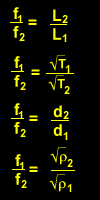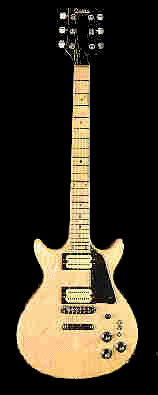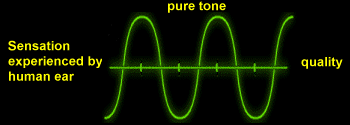Standing Waves in Strings
The Guitar Lesson

Vibrating Strings
It is possible to have two strings of the same length and with the same
tension, but with different frequencies. This can occur because the frequency
is also affected by the diameter of the string and its material.
The exact dependence of the frequency of a vibrating string on each of
these factors can be determined experimentally. The results are summarized
below:

-The frequency increases when the length decreases. The frequency varies
inversely with the length. For example, if the length is halved, the frequency
doubles.

-The frequency increases when the tension increases. The frequency varies
directly with the square root of the tension. For example, if the tension
increases by a factor of four, the frequency doubles.

-The frequency increases when the diameter decreases. The frequency varies
inversely with the diameter. For example, if the diameter is halved, the
frequency doubles.

-The frequency increases when the density decreases. The frequency varies
inversely as the square root of the density. For example, if the density decreases
to one quarter of its former value, the frequency doubles.
The following are alternative expressions that could be used.

The Guitar Lab
This analysis is based on the actual measurement of string lengths on a guitar fret board
A handout sheet of this is provided which gives fretboard spacings, guitar string diameters based on "Dean Markely" mediums and a list of frequencies. Frequencies are found in the accompaning note Click Here
Modes of Vibration - Quality of Sound

In a vibrating string stretched between two fixed points, nodes occur at both
ends. Different frequencies may result, depending on how many loops and nodes
are produced.
In the simplest mode of vibration, the fundamental mode,
the string vibrates in one segment, producing its lowest
frequency or pitch, called the fundamental frequency
, fo. If the string vibrates
in more than one segment, the resulting modes of vibration are called
overtones.
Since the string can only vibrate in certain patterns, always
with nodes at each end, the frequencies of the overtones are simple (whole
numbered) multiples of the fundamental frequency, called
harmonics, such as 2fo,
3fo, 4fo, and so on.
A table of harmonics is given below

Very few vibrating sources can produce a pure note without overtones.
The quality of a musical
note depends on the number and relative intensity of the overtones it produces,
along with the fundamental. It is the element of quality that allows us to
distinguish between notes of the same intensity and frequency coming from
different sources.
An oscilloscope is an instrument used in the study of sound waves emitted
from different sources. Oscilloscope patterns show that the resultant wave,
for a given frequency, is unique for each instrument.
 Click here to listen to a guitar sound.
Click here to listen to a guitar sound.
Oscilloscope Tracings:


Oscilloscope patterns can be used to illustrate the three characteristics
of musical sound which are the intensity or loudness, the quality (number of overtones or harmonics and frquency or pitch.
Problem
What relationship exists between the length of a vibrating string and the frequency of the sound produced?
Make an hypothesis and then using an acoustic guitar the hypothesis will be tested.
Materials
A guitar, measuring tape, guitar fret board chart showing all notes, graph paper, frequency reference source
Procedure
- Any string may be used. The fourth string (open D) will be used (Why? --> Notes fit very nicely into the treble clef)
- The distance from the nut to the bridge is recorded
- The distance between each fret is measured and recorded on the fret board chart for one complete octave which is twelve frets or
the length to each successive fret may be measured for the twelve string lengths
- Frequencies are found in the accompaning note Click Here
- Organize the data into a chart with these headings:
string length (cm), frequency(Hz) musical note (letter)
- Construct a graph of string length versus frequency --> Graph #1
- Construct a second graph of the product of string length times frequency (l x f) versus string length --> Graph #2 (round off to two digits for good results)
- A graph of string diameter versus frequency can be constructed using all six open strings --> Graph #3
String diameters should be listed at the bottom of the fret board chart
Answer all of the following questions in each of the three sections
Analysis and Interpreting
- Describe the shape of each of the graphs that you constructed.
- Find the slope of the line in Graph #2.
What does this slope represent?
- What is the fundamental frequency of the open D string?
Where are the nodes located for this fundamental frequency?
Calculate the wavelength of this note.
Calculate the speed of this transverse wave. Thid id not the speed of sound in air but the speed of the vibrating string.
- What are the frequencies of the first three overtones?
How do these frequencies relate to the fundamental frequency?
- Explain what an octave is and verify that the twelfth fret is an octave of any open string.
- In the graph of string diameter versus frequency, comment on the accuracy of the data.
Explain why this data may be unexceptable in a true scientific study.
- If the frequency of an A# note is 233 Hz, what is the frequency of the F note on the same string
Refer to fret board chart and measurements.
Extended, Applications
- Highlight on your fretboard chart all notes that have the same frequency as the open D (4th string).
- Find all the D notes that are one octave higher than the open string D note and hightlight them in a different colour from question 1.
- The only way to tune a guitar is the adjust ..........
- The first string (E) of a guitar is accurately tuned to a pitch pipe. When tuning the next string (B), three beats per second are heard.
What are the possible frequencies that this string may have?
On tightening the string 4 beats per second are heard. What should be done to tune the two strings?
- A guitar has six strings. What variables are fixed and which change from string to string.
- The normal way to tune a guitar is to ......
Notes to be Made
- List the factors that affect the frequency of a vibrating string
- The two fixed points, at each end, are ______________ of a standing wave pattern.
- In a vibrating string, only waves of multiple half units are allowed.
The lowest allowed frequency of a vibrating string will have a wavelenth of ______________ the length of the string. This frequency is also called the ________________ of that string.
The next highest frequency will have a string length that is exactly ________ wavelength. And so on.
- Explain what an overtone is. What are harmonics?
- Sketch diagrams to show a vibrating string or rope in the first four harmonics.
- What is meant by an octave?
- Research question: If you were to play the scale of B major, starting on the 4th string, what notes would you play?
Hint: this can be figured out using the frequency notes for the C scale or the fretboard, both found in the Guitar Frequency note.



 Click here to listen to a guitar sound.
Click here to listen to a guitar sound.

